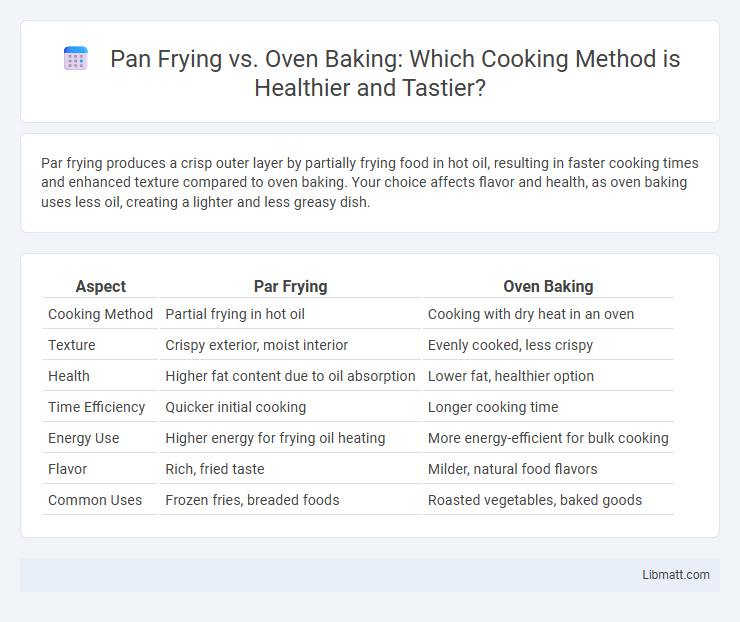Par frying produces a crisp outer layer by partially frying food in hot oil, resulting in faster cooking times and enhanced texture compared to oven baking. Your choice affects flavor and health, as oven baking uses less oil, creating a lighter and less greasy dish.
Table of Comparison
| Aspect | Par Frying | Oven Baking |
|---|---|---|
| Cooking Method | Partial frying in hot oil | Cooking with dry heat in an oven |
| Texture | Crispy exterior, moist interior | Evenly cooked, less crispy |
| Health | Higher fat content due to oil absorption | Lower fat, healthier option |
| Time Efficiency | Quicker initial cooking | Longer cooking time |
| Energy Use | Higher energy for frying oil heating | More energy-efficient for bulk cooking |
| Flavor | Rich, fried taste | Milder, natural food flavors |
| Common Uses | Frozen fries, breaded foods | Roasted vegetables, baked goods |
Introduction to Par Frying and Oven Baking
Par frying partially cooks food by briefly frying it in hot oil, creating a crispy outer layer while retaining moisture inside, commonly used for frozen fries and snacks. Oven baking cooks food using dry heat in an enclosed space, promoting even cooking and browning without excess oil, ideal for healthier meal preparation. Both methods offer distinct texture and flavor profiles suited for specific culinary needs.
Key Differences Between Par Frying and Oven Baking
Par frying involves partially cooking food in hot oil, typically between 300-350degF, resulting in a crispy exterior and moist interior, while oven baking cooks food using dry heat at temperatures usually ranging from 325-450degF, producing a more evenly cooked and less greasy product. Par frying reduces overall cooking time when later finished by frying or baking, whereas oven baking takes longer but is often considered healthier due to reduced oil usage. Texture and flavor profiles differ significantly, with par fried foods offering a crunchier bite compared to the softer, more uniform texture from baking.
Techniques Involved in Par Frying
Par frying involves partially frying food in hot oil, usually at temperatures between 320degF to 350degF, to achieve a crisp exterior while maintaining a tender interior. This technique requires precise timing and temperature control to avoid overcooking or sogginess, often followed by a finishing step such as oven baking or deep frying. Par frying is commonly used for products like French fries and chicken, enabling faster cooking during final preparation and enhancing texture and flavor.
Step-by-Step Guide to Oven Baking
Oven baking involves preheating your oven to the desired temperature, usually between 350degF and 425degF, depending on the recipe. Place your food on a baking sheet or in a dish, ensuring even spacing for consistent cooking, then bake until the internal temperature reaches safety standards or the texture is desired. Your food will develop a crispy exterior with a tender interior while retaining moisture better than par frying.
Flavor and Texture Comparison
Par frying locks in moisture and creates a crispy, golden crust, enhancing flavor through Maillard reaction caramelization. Oven baking produces a more evenly cooked, tender interior with a drier texture but allows natural flavors to develop gradually. The choice impacts flavor intensity and mouthfeel, with par frying offering a richer taste and oven baking delivering a subtle, uniform finish.
Health Impacts: Par Frying vs Oven Baking
Par frying often involves submerging food briefly in hot oil, significantly increasing its fat content and calorie levels compared to oven baking, which uses hot air circulation and requires little to no added oil, making it a healthier cooking method. Oven baking helps retain more nutrients such as vitamins and antioxidants due to lower temperatures and less oil exposure, reducing the risk of heart disease and obesity associated with fried foods. Choosing oven baking over par frying can result in lower intake of trans fats and harmful acrylamide compounds, promoting better cardiovascular health and weight management.
Time and Convenience Factors
Par frying significantly reduces cooking time by partially cooking food in hot oil, making it ready for quick finishing, ideal for busy schedules. Oven baking typically requires longer cooking times but offers hands-off convenience, allowing you to prepare larger quantities with minimal active supervision. Your choice depends on whether you prioritize speed or ease of multitasking in the kitchen.
Best Foods for Par Frying
Par frying is ideal for foods like French fries, chicken wings, and breaded fish fillets, where a crispy exterior and tender interior are desired without full cooking. It works well on frozen foods, allowing you to partially cook items before finishing them later in the oven or on a grill. Your best choices for par frying include starchy vegetables, breaded proteins, and snack items that benefit from quick, high-heat oil exposure.
Ideal Dishes for Oven Baking
Oven baking is ideal for dishes that benefit from even heat and moisture retention, such as casseroles, roasted vegetables, and baked goods like bread and cookies. This method helps develop a crispy exterior and a tender interior, perfect for whole chickens, lasagna, and sheet pan meals. Your results will be more consistent and flavorful when using oven baking for these types of recipes.
Choosing the Right Method for Your Recipe
Par frying retains moisture and produces a crispy texture quickly, ideal for foods like potatoes or chicken where a golden crust is desired without overcooking the interior. Oven baking offers even heat distribution, making it perfect for larger cuts or casseroles that require thorough cooking and a tender finish. Your choice depends on balancing texture preferences and cooking time to achieve the best result for your specific recipe.
Par Frying vs Oven Baking Infographic

 libmatt.com
libmatt.com